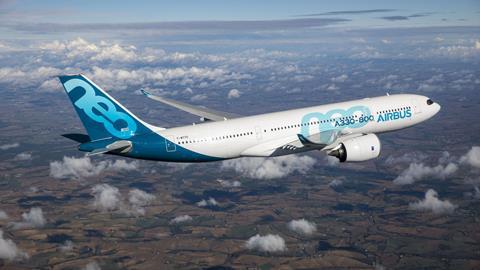The Airbus A330neo family is a 21st century refinement of the highly successful A330/A340 family. This pair of twin and quad widebodies was formally launched in June 1987 using the 222in (5.64m) wide fuselage cross-section of the original A300 series, combined with a new wing and engines.
Fresh off the development and certification of its single-aisle A320, Airbus incorporated its then ground-breaking fly-by-wire flight control system and state-of-the-art glass, sidestick-controller equipped flightdeck.

The A330 and A340 had been developed in parallel with their major difference being the number of engines fitted under the common wing. While many saw the future of long-haul aviation in twin-engined form, many potential operators favoured a more traditional four engine offering for very long routes, particularly those over water. Extended-range twin-engine operations (ETOPS) operations were newly established and many operators with small fleets, especially those outside of North America, weren’t convinced of its benefits.
Although the four-engined A340 was first to enter service – in March 1993 – it was the twin-engined A330 that became the long-term sales success. By March 2019, Airbus had delivered 1,444 of the twinjets and had a further 290 on firm backlog.
By the time technological advancements had made a successor to the A330/A340 family viable, production of the quad had since long ceased as all market demand shifted to the twinjet. Airbus initially proposed an updated, re-engined A330 a decade ago as part of its early A350 proposal before deciding to adopt the clean-sheet A350 XWB design to counter the then new Boeing 787 as well as the 777. It revisited the re-engined A330 in 2014 to plug a hole in its product line after plans for a smaller -800 variant of the A350 was shelved.
Dubbed A330neo (new engine option), the re-engined twinjet family was launched at the Farnborough air show in July 2014. With power coming from the Rolls-Royce Trent 7000 engine – itself evolved from the 787’s Trent 1000-TEN – the new aircraft is offered as two variants – the A330-200-sized -800 and the larger -900 based on the -300 platform.
The common wing on the original A330/A340 resulted in a less-than-optimal design for both. For the A330neo, Airbus was free to develop and optimise the wing around the twinjet configuration. Various aerodynamic refinements were made to the wing, the design of which dated back three decades, resulting in a higher aspect ratio wing of 11, which allows for a slightly faster cruise speed.
The key change is the incorporation of A350-like sharklets which increase span to 64m (210ft) from 60.3m on the earlier A330ceo family. Other aerodynamic changes include reshaped low-profile flap-track fairings, a revised upper belly fairing and a newly designed inboard slat (slat 1).
Design tweaks
The slat change is part of the optimising of the wing around the twin configuration which involves a cleaning up of the design and the removal of the “dog-tooth” gap between the slat and the leading edge, says A330 head of marketing Crawford Hamilton.
“The slat actually stuck out in front of it and looked pretty ugly,” he says. “Now that’s all been cleaned up because this is the first wing ever designed for the A330. All A340 [optimisation] has been swept away.”
Like its predecessor, the A330neo’s wing is of conventional metal construction. Airbus shows a net fuel efficiency increase due to the wing and aerodynamic improvements of 4%.
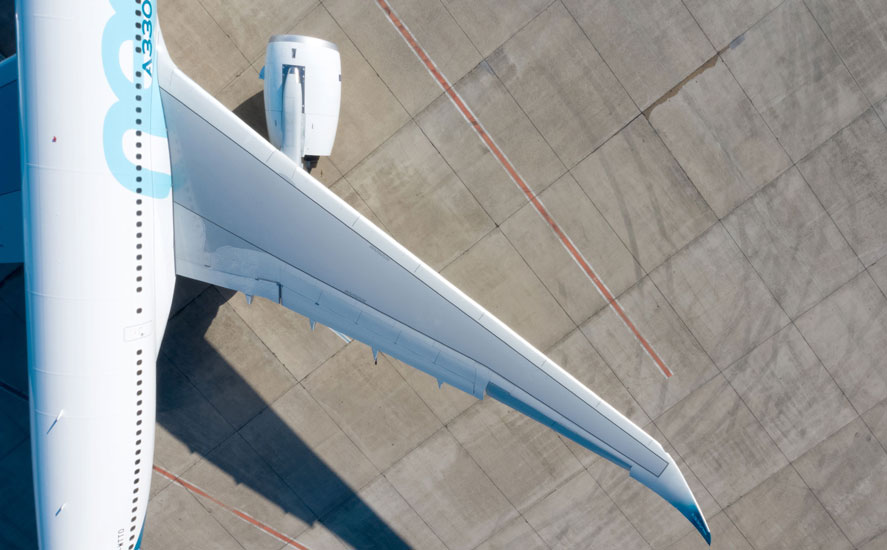
Aerodynamic changes on wings include low-profile flap-track fairings and new inboard slats
Airbus
However, it is primarily the advancements in propulsion efficiency that has made a new A330 a viable rival to the 787 in the marketplace. The 68,000-72,000lb thrust (303-320kN) Trent 7000 features a large 2.84m diameter fan, with a 10:1 bypass ratio. The three-spool powerplant provides an 11% reduction in thrust specific fuel consumption over the legacy Trent 700 engine option. This saving is not fully realised, as the new engine weighs in at 1t (2,200lb) heavier than its predecessor. The realised gain is also further offset by the increased weight of the new pylon and wing structure needed to accommodate the heavier engine.
When summed, the A330neo’s aerodynamic and propulsion enhancements yield a net fuel efficiency increase of 12% over the A330ceo. Compared with the previous generation 767-400ER and 777-200ER, Airbus asserts that the A330neo family offers 25% fuel savings.
In addition to reduced sector operating costs over the previous A330-200, the A330-800 offers a range increase of 650nm (1,200km) at 242t maximum take-off weight, while the longer-range 251t MTOW -800 delivers a 1,300nm range advantage.
Airbus has also updated the A330neo cabin to the new “Airspace” standard derived from the A350’s interior. Slimline seats are incorporated along with revised passenger with restricted mobility (PRM) lavatories. Rather than taking the space of two non-PRM lavatories, as the previous PRM configuration had done, the new PRM design incorporates moveable rigid dividers to temporarily convert two lavatories into a PRM facility.

The thinner seats and reduced lavatory footprint allow Airbus to increase the -800’s seating to 257 – 10 more than the -200’s. The -900, which is extended by 11 fuselage frames, typical seats 287, again 10 more than the -300 it is based on. Airbus says that the bottom line is that the two A330neo variants carry more passengers farther at less cost than their predecessors.
My first exposure to the Airbus fly-by-wire common cockpit was in the A340-600, itself a stretched and re-engined derivative of the original A340-200/300. This cockpit layout was first fielded with the A320 in 1988 and is common across the A320 family variants as well as the A330/A340.
The forward instrument panel had six 4.7 x 4.7in colour liquid crystal displays, a primary flight display (PFD) and navigation display (ND) for each pilot, plus two displays for the electronic centralised aircraft monitoring (ECAM) system. The primary difference between them was the A340 had two more thrust levers.
At the time the A340’s flightdeck was state of the art. Airbus has made welcome improvements to flightdecks on the newer A380 and A350, such as increased size and number of displays, hardwired electronic flight bags (EFBs) and a full-size QWERTY keyboard. In a move to reduce costs and development time, Airbus has kept the legacy A330 flightdeck for its Neo offering.
To be fair, the A320-based common flightdeck has aged gracefully. While no longer state of the art, it is still quite utile and feels less “retro” than that in the latest narrowbody from a rival OEM. Airbus, however, has spiced up the Neo cockpit, incorporating the runway overrun protection system (ROPS) feature found on the A350. If an overrun is sensed, with the autobrake armed for rollout, it commands maximum braking and issues visual and aural alerts for the pilots to use maximum reverse thrust.
Brake to vacate, another feature offered on the A350 and A380, is on Airbus’s roadmap for future enhancements to the A330neo’s flightdeck.
One enhancement both the captain and first officer might benefit from is wi-fi, which will facilitate the fielding of EFBs. One addition sure to be liked by the first officers is the second head-up display (HUD) on the flightdeck.
Second variant certification
The larger -900 has proved by far the most popular A330neo edition so far, and that variant was brought to market first. The -900 first flew in October 2017 and entered service with TAP Air Portugal in December 2018. A total of five aircraft had been delivered to TAP by the end of March. For the -900 test campaign, a total of three aircraft were used.

Gerzanics took left seat during the flight from Toulouse to test A330neo handling qualities
Max Kingsley-Jones / FlightGlobal
The -800 first flew in November 2018, and the single test aircraft has completed approximately half the test programme; It is on track for certification in the second half of this year, although the current launch operator, Kuwait Airways, is not due to take its first aircraft until 2020.
With A330neo family development on an established solid footing, FlightGlobal was invited to Toulouse-Blagnac airport to sample the handling of the re-engined twinjet.
Our preview aircraft was the single -800 test aircraft (MSN 1888, registration F-WTTO). At the time of our preview flight, the aircraft was primarily being used to refine the flight-control laws first developed for the -900.
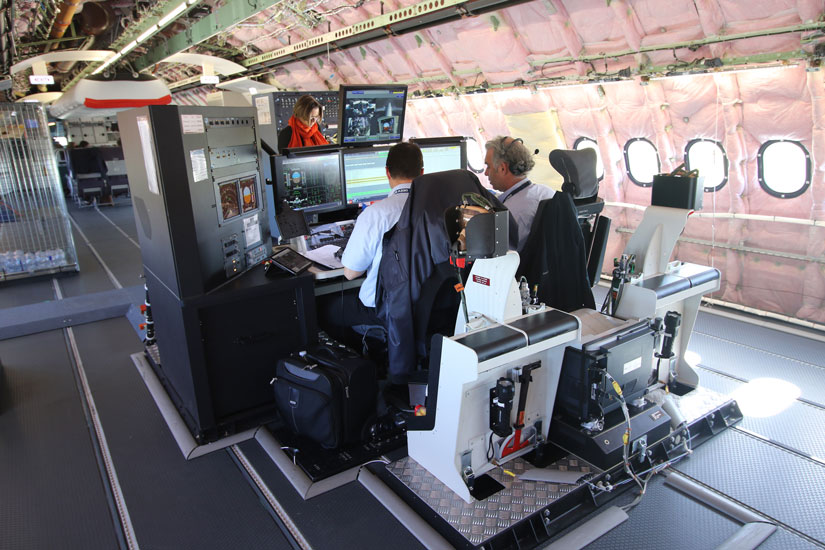
Onboard work stations allow for speedier flight-control scheme changes while airborne
Max Kingsley-Jones / FlightGlobal
The -800’s shorter length necessitates changes to the -900’s rotation and de-rotation laws, which had themselves been altered from the legacy A330ceo to account for the heavier and more powerful engines. The preview aircraft’s passenger compartment was fitted with flight test equipment and work stations. These stations allow flight control schemes to be changed in flight, speeding flight control development. In the cargo holds, ballast barrels were installed for gross weight and centre of gravity control. Our aircraft had an empty weight above that of a production aircraft, but from an aerodynamic and propulsion standpoint was production representative.

Cockpit layout feels fresh despite layout dating back to that of original A320 from 1987
Max Kingsley-Jones / FlightGlobal
The preflight walk around inspection had been completed prior to our arrival at the aircraft on Airbus’ test ramp. After following Airbus test pilot Thomas Wilhelm onto the flightdeck, I strapped into the left seat. While I don’t routinely fly Airbus aircraft, I found the flightdeck quite familiar – a strength of the Airbus product line is its common cockpit.
Wilhelm guided me through the preflight procedures and once towed to the start point, both Trent engines were started. The full-authority digital engine control (FADEC) start sequence was refreshingly short when compared with that typical of the smaller CFM International Leap and Pratt & Whitney geared turbofan powerplants.

Trent 7000 engine generates an 11% saving in fuel consumption versus predecessor’s 700
Max Kingsley-Jones / FlightGlobal
During the taxi to Blagnac’s runway 32L, I referenced a flight-test specific glareshield mounted display to train my arm for the rotation sidestick pull. A consistent repeatable pull is essential for accurate data needed to develop the rotation control scheme. For our take-off we would be utilising what Airbus hoped to be its best and final rotation law.
With flaps set to configuration 2, takeoff safety speeds for our 182.8t weight – including a 48t fuel load – were 137/137/146kt V1/Vr/V2, respectively (all speeds are indicated air speed - KTIAS). Once cleared for take-off, I ran the engines up to 50% N1 while holding the brakes.
After releasing the toe-actuated brakes, I pushed the thrust levers to the “FLX/MCT” detent, with the autothrust system setting a FLX (50˚C) N1 of 88.4%.
Only 25s had elapsed from brake release when Wilhelm called rotate. An approximate 5kg aft pull rotated the A330-800 to our desired 15˚ lift-off attitude. Once airborne, sidestick force changes for gear and flap retraction during acceleration for a 250kt climb were negligible. I hand flew the aircraft as we climbed into a block of altitude between flight level 80 (8,000ft) and FL150 (15,000ft) to examine the A330neo’s roll axis handling qualities as well as its high- and low-speed characteristics.
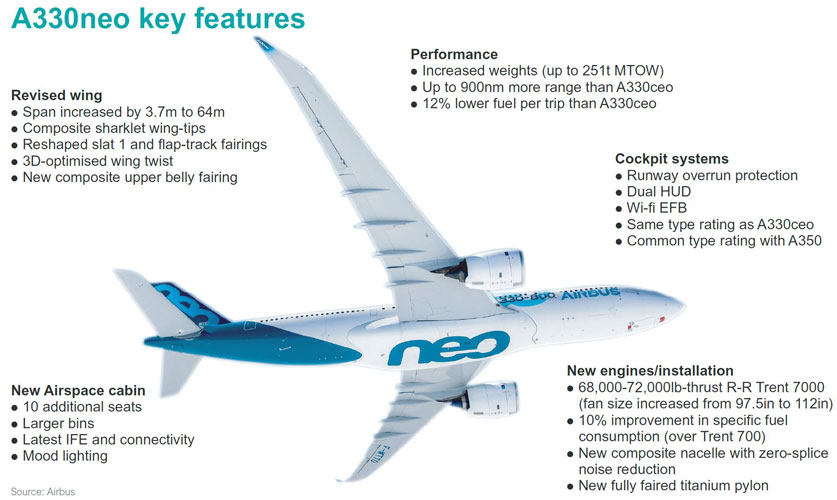
Manoeuvres at the limits
The first area manoeuvres were a series of turns at 250kt to capture specific headings, at angles of bank from 30˚ to 45˚. Using only the sidestick, I found I could easily capture and maintain desired bank angles. The A330neo’s crisp roll characteristics also allowed me to smoothly roll out on desired heading. With the roll exercise complete, the thrust levers were advanced to accelerate the aircraft at FL110 to 320kt, just below Vmo (330kt).
As was expected, there were no sidestick force changes during the acceleration, the Airbus having no apparent speed stability in Normal Law. After briefly stabilising at 320kt, I retarded the thrust levers to the IDLE detent and deployed the speed brake to FULL. The Neo rapidly slowed, and passing 180kt, I retracted the speed brakes. The flaps were extended to configuration 3 as we further slowed, and stabilised at 118kt, AlphaPROT – top of the yellow on the primary flight display airspeed tape. Had I forgotten to retract the speed brakes, they would have automatically retracted there.
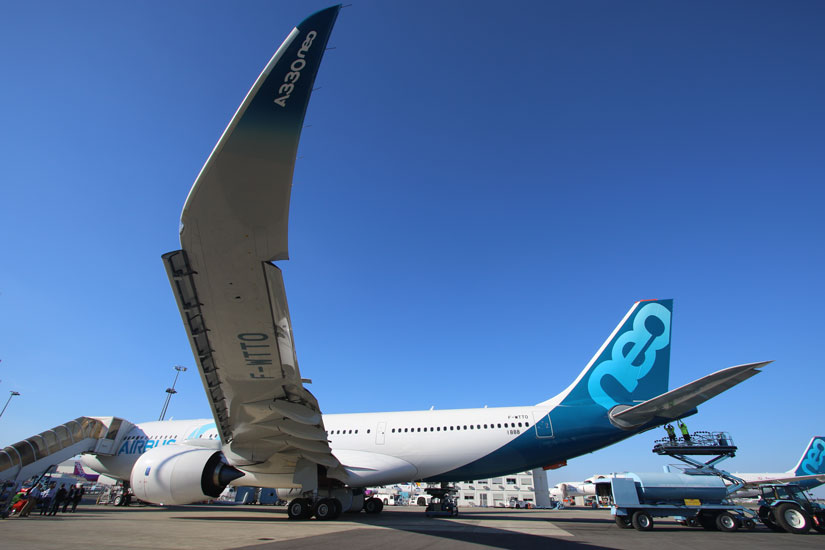
Wingspan has been raised to 64m with sharklets similar to those on A350
Max Kingsley-Jones / FlightGlobal
At AlphaPROT, the sidestick stops commanding g and commands angle-of-attack. Like a conventional flight control system, continued aft sidestick pressure was required to further slow the aircraft. Before reaching the slower AlphaFLOOR, the low-energy “speed, speed, speed” warning triggered.
With the sidestick displaced fully aft, AlphaFLOOR was reached (110kt for our conditions) where the autothrust engaged to advance thrust to take-off/go-around (TOGA).
With full aft sidestick, the A330-800 powered into a stable 27˚ nose-high climb at 1,000ft/min (5.1m/s). Recovery from the high-attitude low-speed condition was affected by lowering the nose to the horizon with maximum continuous power maintained until we had accelerated to about 150kt.
The last and most impressive area manoeuvre was performed in a landing configuration, gear down and full flap. It would simulate a terrain avoidance event that required a turn away from an obstacle. It should be noted that this was not a flight crew operating manual (FCOM) manoeuvre, as FCOM procedures call for a wings-level pull.
In level flight at 150kt I parked the sidestick in the aft left quadrant and advanced the thrust levers to the TOGA detent. The nose smoothly climbed to a 28˚ high attitude while rolling into a stable 48˚ angle of bank left turn. Speed decreased and settled at 112kt, as the A330 smoothly climbed skyward at a rate of over 1,000ft/min. The conclusion from the last two events was how easily the A330neo can deliver maximum performance. These carefree handling qualities enable the pilot to aggressively manoeuvre the aircraft at the limits, a real operational safety benefit.
Offset landing task
After completion of the area manoeuvres we turned towards Toulouse and prepared for an instrument approach to 32L. ATC provided vectors to final as Wilhelm installed and activated the ILS/localiser for 32L.
One area where Airbus felt the A330ceo’s handling qualities warranted improvement was in the lateral-directional axes in landing configuration. Pilots had expressed a desire for crisper roll response. I had been impressed by its handling in a clean configuration and would use the precision approach to see how the A330neo felt when in landing configuration.
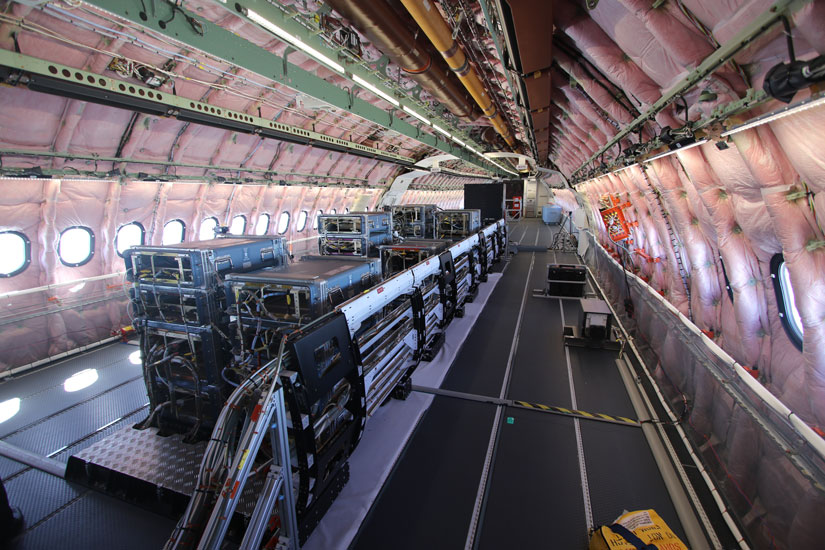
The main section of our A330-800’s passenger cabin was fitted with flight-test equipment
Max Kingsley-Jones / FlightGlobal
With all the automation turned off, I captured the localiser well outside the final approach fix. The aircraft was configured for landing with gear down and full flap, while slowing to a target speed of 142kt. Approaching the final approach fix at glideslope intercept attitude, I was dismayed to see the glideslope had gone out of service.
Wilhelm suggested using the HUD to visually establish a 3˚ glide path while he installed the GBAS landing system (GLS) approach, which uses ground-based augmentation to provide a near precision approach capability.
Aside from differing flight mode annunciators, it is flown just like an instrument landing system. Full flight director guidance was now available on both the HUD and PFD. Stabilised on the glideslope inside the final approach fix, I offset about one dot left of the final approach course.
When 1,000ft was called, I aggressively manoeuvred to recapture the final approach course. By 500ft above ground level I had rolled out wings level on the runway centreline, the A330-800 crisply responding to my inputs. Passing 50ft, before “Retard” automatically sounded, I slowly retarded the thrust levers to IDLE.
Passing 30ft, I started the round out portion of the flare manoeuvre. With the sink rate arrested, relaxation of sidestick back pressure allowed the main gear to settle on the runway. After lowering the nose gear to the runway, I used thrust reverse alone to slow below 70kt. After stowing the reversers, wheel brakes were used to slow the A330 for runway turn-off and taxi back.
By upgrading one of the world’s most popular widebodies with more efficient engines and aerodynamic tweaks, Airbus’ new A330neo family looks capable of giving the Boeing 787 a true run for its money. Airline accountants will appreciate the lower operating costs while passengers will benefit from the quieter and more comfortable cabin.
Notable strengths of the Airbus commercial product line are the common cockpit and handling qualities that are, by design, as alike as possible. When I flew the A340-600 over 17 years ago I found it had “handling qualities that belied its large size”. While my direct memories of that flight have faded, my flight in the A330-800 reminded me how good flight-control design could make a large aircraft feel smaller.
A330neo pilots will surely appreciate how they fly. With attributes that will certainly appeal to all major stake holders, the A330neos are on track to continue the runaway sales success of their previous generation siblings.
Source: Flight International

















